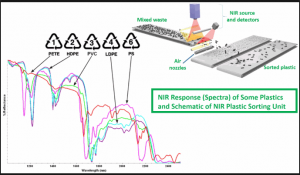Sorting Polymers by Unique Spectral Features
This application note was written by Yvette Mattley, Ph.D., and Derek Guenther.
With their widespread use and near ubiquitous presence in our daily lives, plastics enjoy a high level of public awareness – both positive and negative. One area of special interest among folks of all perspectives – from researchers and manufacturers to environmentalists and regulators — is plastics recycling.
In this application note, they explore how spectroscopy can be used in plastics recycling to identify and sort a variety of plastics with a high degree of specificity.
Background
The synthetic materials comprising some plastics use macromolecules such as polymers. These polymers are commonly manufactured through injection molding at low temperatures, suggesting that reuse of the materials via recycling is simple. However, very few types of plastics can be blended into homogeneous mixtures, which makes it necessary to cleanly separate the different polymers in the recycling stream.
Because techniques like NIR spectroscopy and Raman analysis provide useful information about material characteristics including chemical composition, they’re effective in identifying plastics for recycling. Integration of spectroscopy into recycling streams can make processes simpler by mitigating the need for some sorting steps.
At NIR wavelengths (>800 nm), polymers have strong, distinct spectral features, which closely correlate to the recycling codes imprinted on plastics (Figure 1). Also, with NIR spectroscopy, there’s very little sample preparation to be done. Setups are flexible and customizable to many different situations.

Figure 1. Most coded plastics have distinct spectral features in the NIR. Spectrometers can be integrated into recycling processes to help sort plastic types.
In some cases, Raman spectroscopy can be used to identify unknown compounds. Indeed, under the right conditions – i.e., at sufficient signal levels and with adequate methods to mitigate interference from fluorescence — Raman is highly specific for plastics identification.
As effective as Raman and NIR spectroscopy can be for clear and colored plastics identification, neither method is well suited for identification of black polymers. That’s because carbon black absorbs all the Raman excitation laser light and all the light in the NIR region. However, there are references in the literature to the use of mid-IR spectroscopy techniques for identifying black polymers.


